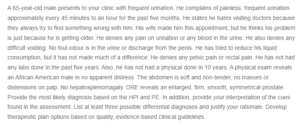Gastrointestinal Case Study Analysis-65-Year-old Man
Diagnosis
The most likely diagnosis based on the 65-year-old man’s HPI and PE is Benign Prostatic Hyperplasia (BPH). My interpretation of the cues found in the assessment as per the HPI and PE leading to the diagnosis of BPH is as follows: First, the patient is a 65-year-old man. Age and gender are major risk factors for the development of BPH, with 50 per cent of men above the age of 50 years at increased risk of BPH (Shergill et al., 2022). Although the 65-year-old man has reduced his consumption of fluids, his major complaint is his frequent urination, which is been almost every 45 minutes in the last five months. An increased frequency of urination is a major BPH symptom (Johns Hopkins Medicine, 2023). The digital rectal exam (DRE) revealed that the patient has an enlarged, firm, smooth, symmetrical prostate. BPH involves an enlargement of the prostate gland (Shergill et al., 2022). Additionally, the patient’s health history shows that he has not had any labs done in the past five years and has had no physical examination in the last ten years. As a 65-year-old man, it is important for regular health checks to reduce the risk of complications due to undiagnosed disease progression.
Possible Differential Diagnoses and Rationale
Other differential diagnoses that can be made in this case are prostate cancer, a urinary tract infection (UTI), and Type 2 diabetes mellitus. The cancer of the prostate can be diagnosed based on the findings of the DRE, which show an enlarged prostate and frequent urination, which are both consistent with prostate cancer. Although a urinalysis is required, a UTI infection cannot be ruled out as it is accompanied by symptoms as manifested by the 65-year-old man, such as increased frequency and urgency of urination. Lastly, despite the absence of common symptoms such as thirst or the need to drink water, Type 2 diabetes mellitus can be included in the differential diagnosis due to the patient’s age and the increased frequency of urination. Although the major diagnosis based on the symptoms is BPH, other tests related to prostate cancer, UTI, and diabetes mellitus will be required to help rule out these conditions.
Therapeutic Plan Options
For the patient to be able to manage the BPH and other underlying factors contributing to the development of the symptoms, these three therapeutic plan options are proposed: an observational plan, medical therapy, and surgery. The observational plan involves not providing medical therapies but employing watchful monitoring of the patient through regular checkups while assisting the patient with lifestyle changes such as weight loss and healthy living, including fluid intake and avoiding constipation (Shergill et al., 2022).
The second therapeutic option is medical therapy. The medical therapy plan can include Alpha Blockers such as Alfuzosin (10mg once daily) and Tamsulosin (400 once daily), whose mechanism of action includes relaxing prostate and bladder neck smooth muscles to improve urine flow and BPH symptoms (Shergill et al., 2022). Medications that can be considered include 5-alpha Reductase Inhibitors (5-ARIs) and antimuscarinics, which have proven effective in reducing BPH symptoms (Shergill et al., 2022). Surgery is the last therapeutic plan option based on quality, evidence-based clinical guidelines. Surgery can be used if the medications for the management of the BPH are ineffective in reversing its progression and if its progress leads to other urinary complications.
References
Johns Hopkins Medicine. (2023). Benign Prostatic Hyperplasia (BPH). https://www.hopkinsmedicine.org/health/conditions-and-diseases/benign-prostatic-hyperplasia-bph
Shergill, I. S., Dhanasekaran, A. K., Kalsi, J. S., & McAllister, W. J. (2022). Benign Prostatic Hyperplasia. Viva Practice for the FRCS(Urol) and Postgraduate Urology Examinations, Second Edition, 279–296. https://doi.org/10.1201/9781351254540-19
ORDER A PLAGIARISM-FREE PAPER HERE
We’ll write everything from scratch
Question 
A 65-year-old male presents to your clinic with frequent urination. He complains of painless, frequent urination approximately every 45 minutes to an hour for the past five months. He states he hates visiting doctors because they always try to find something wrong with him. His wife made him this appointment, but he thinks his problem is just because he is getting older.

Gastrointestinal Case Study Analysis-65-Year-old Man
He denies any pain on urination or any blood in the urine. He also denies any difficult voiding. No foul odour is in the urine or discharge from the penis. He has tried to reduce his liquid consumption, but it has not made much of a difference. He denies any pelvic pain or rectal pain. He has not had any labs done in the past five years. Also, he has not had a physical done in 10 years. A physical exam reveals an African American male in no apparent distress. The abdomen is soft and non-tender, no masses or distensions on palp. No hepatosplenomagaly. DRE reveals an enlarged, firm, smooth, symmetrical prostate. Provide the most likely diagnosis based on the HPI and PE. In addition, provide your interpretation of the cues found in the assessment. List at least three possible differential diagnoses and justify your rationale. Develop therapeutic plan options based on quality, evidence-based clinical guidelines.